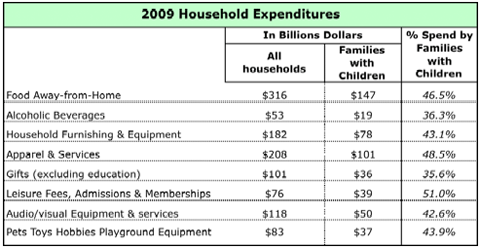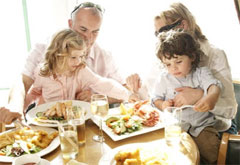
Vol. XI, No. 2, February-March 2011
- Editor's corner
- The importance of your business catering to families with children
- Location-Based Entertainment: How to Beat the Digital World at its Own Game
- Top tips for getting the design right the first time
- Foundations Entertainment University, April 26-28, Dallas, TX
- Make sure your business is found locally on Google and GPS maps
- In the news
- Recent blogs
- Our best on Twitter
- New Projects and Clients
The importance of your business catering to families with children
Businesses hear about the importance of being family-friendly, but they often don’t pay too much attention, thinking that families with children are a minority market that only those businesses specifically targeting that market need to cater to. Well, guess what? Families with children are a much larger market than most people believe, one only to be ignored at any business’s peril.
Yes, families with children (technically in U.S. Census terminology we are talking about households with children under age 18) have decreased as a percentage of all households since 1950. As of 2010, families with children represented about one-third of all households. In most of the developing world, families with children constitute an even much larger share of both households and the population.
But families with children wield a lot of income and spending power. They accounted for 45% of all U.S. household income in 2009. Their economic power is significant in many consumer categories.

Any bricks-and-mortar business, whether a retailer, shopping mall, restaurant, entertainment or recreational facility, or a service business, that ignores the needs of families with children will leave a lot of sales and profit on the table. Those needs often require addressing the presence of younger children who will be in tow on shopping trips, at restaurants or be part of the family that is going out for some form of entertainment, recreation, sporting event or other leisure activity. Almost three-quarters (73%) of families with children have a child younger than age 12, 44% have a child younger than 6 and one-quarter have at least one child 2 years or younger. That adds up to a lot of young kid power influencing spending, both directly and indirectly, both positively and negatively.
Paco Underhill of Envirosell, the world-respected retail anthropologist, put it this way, “School-age children make incessant demands for toys and foods. Toddlers quickly learn they can affect their parents’ behavior in stores. Even the smallest infant can cause a frazzled parent to abandon a shopping trip by throwing a tantrum in the middle of a supermarket. It makes sense to think about young children as a presence, if not a force, in commercial and retail environments.” Yes, how well a business meets the needs of both children and their accompanying parents (or grandparents) not only affects whether they come and how often, but how long they stay and how much they spend.
Family-friendly encompasses a multitude of factors, especially when it comes to younger children. This includes the evolutionary programming of children to interact with the environment and all its objects, often in ways that are inappropriate, to children’s eating preferences (and those of what their parents would like them to eat), children’s short attention spans and easy boredom, to restrooms with urinals, toilets and sinks that work for children. Children develop in different stages, making it even more challenging, as what works for a 2-year-old is far different than what works for a 6-year-old, which is different than what works for a 10-year-old. The needs of adults with children in tow range from maneuvering strollers through doors, between tables and through aisles, to restroom facilities that have parent-friendly, easy-to-use diaper changing facilities, to mothers’ obsession with their children’s safety (both injury and abduction), to the cleanliness of everywhere mothers take their children and everything that their children can touch or mouth. Being family-friendly means attention to dozen of details, most of which would be of little concern to most adults not traveling with children. It takes extra effort both in design and operations to really please the family with children market and make them loyal customers.
 A recent SMG Benchmark study showed just how more challenging it is to satisfy this important family segment in restaurants. Their research found that restaurant customers who visit with children under age 12 are less satisfied than those who visit without children and also less likely to recommend the restaurant or return. This is likely due to how many restaurants are not really family-friendly, although they might think they are by having a children’s menu.
A recent SMG Benchmark study showed just how more challenging it is to satisfy this important family segment in restaurants. Their research found that restaurant customers who visit with children under age 12 are less satisfied than those who visit without children and also less likely to recommend the restaurant or return. This is likely due to how many restaurants are not really family-friendly, although they might think they are by having a children’s menu.
In this age of social media, just let a mom have a bad experience or find that the business is not accommodating to her and her children’s needs and it will be Tweeted, blogged or Facebooked across the Internet within hours.
For over twenty years, our company has been designing facilities and working with businesses that want to attract business from this significant market segment. We are unique in our ability to understand this market and their needs, as we have a staff education and child development director and have conducted extensive research on the needs and wants of both children and their parents. We have consulted for and conducted family-friendly audits for many prestigious businesses including the Kennedy Space Center Visitor’s Center, Pizza Hut, Old Sturbridge Village and shopping malls and have assisted many businesses with family-friendly designs and operations. In every situation, there was significant room for improvement to attract the families with children. And of course, we have designed and produced many types of successful family entertainment and children’s edutainment and play facilities that are totally dependent on this market for their success. In all our work with the family with children market, we have observed that when you get it right, when your business is truly family-friendly, you have won a customer for life, or at least until the children grow to be teenagers.
Vol. XI, No. 2, February-March 2011
- Editor's corner
- The importance of your business catering to families with children
- Location-Based Entertainment: How to Beat the Digital World at its Own Game
- Top tips for getting the design right the first time
- Foundations Entertainment University, April 26-28, Dallas, TX
- Make sure your business is found locally on Google and GPS maps
- In the news
- Recent blogs
- Our best on Twitter
- New Projects and Clients


